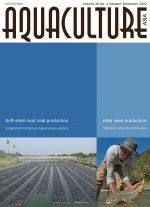Sustainable livelihood model for coastal families through seabass fingerling production: A success story
12 October 2022 | D. Deboral Vimala, C.V. Sairam, M. Kailasam, K. Ambasankar, K.K. Vijayan, P. Mahalakshmi, S. Sivananam, R. Subburaj, and G. Thiagarajan | 263 Downloads | .pdf | 1.14 MB | Hatchery and nursery, Livelihoods, gender and social issues, India
Brackish waters offer good prospects for future aquaculture development, as there are fewer competing uses for these resources. Kilarkollai Village (Tamil Nadu, India) has brackish waters on the village periphery, which are under utilised. The majority of the population are landless poor, economically and socially marginalised, and live below the poverty line.
A team from the ICAR-Central Institute of Brackishwater Aquaculture demonstrated nursery rearing technologies in partnership with four Scheduled Caste families from the village, with a view to providing supplementary livelihoods and income. The team provided training, initial inputs and technical support.
This article describes the approach and methodology of the demonstration programme, the socio-economic circumstances of the villagers, the successful outcome and considerations for sustainability and adoption of this approach elsewhere.
Publisher: Network of Aquaculture Centres in Asia-Pacific
Rights: Creative Commons Attribution.

